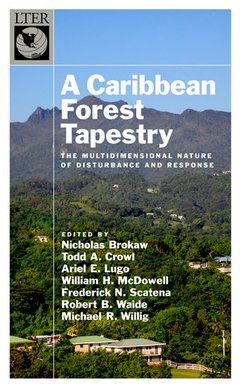Description
A Caribbean Forest Tapestry
The Multidimensional Nature of Disturbance and Response
The Long-Term Ecological Research Network Series
Coordinators: Brokaw Nicholas, Crowl Todd, Lugo Ariel, McDowell William, Scatena Frederick, Waide Robert, Willig Michael
Language: English
Subject for A Caribbean Forest Tapestry:
Publication date: 06-2012
496 p. · 23.6x15.5 cm · Hardback
496 p. · 23.6x15.5 cm · Hardback
Description
/li>Contents
/li>Biography
/li>
Global change threatens ecosystems worldwide, and tropical systems with their high diversity and rapid development are of special concern. We can mitigate the impacts of change if we understand how tropical ecosystems respond to disturbance. For tropical forests and streams in Puerto Rico this book describes the impacts of, and recovery from, hurricanes, landslides, floods, droughts, and human disturbances in the Luquillo Mountains of Puerto Rico. These ecosystems recover quickly after natural disturbances, having been shaped over thousands of years by such events. Human disturbance, however, has longer-lasting impacts. Chapters are by authors with many years of experience in Puerto Rico and other tropical areas and cover the history of research in these mountains, a framework for understanding disturbance and response, the environmental setting, the disturbance regime, response to disturbance, biotic mechanisms of response, management implications, and future directions. The text provides a strong perspective on tropical ecosystem dynamics over multiple scales of time and space.
Dedication. Preface. Chapter 1 - Ecological Paradigms for the Tropics: Old Questions and Continuing Challenges. Ariel E. Lugo, Robert B. Waide, Michael R. Willig, Todd Crowl, Frederick N. Scatena, Jill Thompson, Whendee Silver, William H. McDowell, and Nicholas Brokaw. Chapter 2 - Conceptual Overview: Disturbance, Gradients, and Ecological Response. Bob Waide, Mike Willig. Chapter 3 - Geographic and Ecological Setting. W.H. McDowell, F.N. Scatena, R.B. Waide, N. Brokaw, G.R. Camilo, A.P. Covich, T.A. Crowl, G. Gonzalez, E.A. Greathouse, P. Klawinski, D.J. Lodge, A.E. Lugo,, C.M. Pringle, B.A. Richardson, M.J. Richardson, D.A. Schaefer, W.L. Silver, J. Thompson, D. Vogt, K. Vogt, R.B. Waide, M. Willig, L. Woolbright, X. Zou, J. Zimmerman. Chapter 4 - Disturbance Regime. F. N. Scatena, F. Blanco, K. Beard, R. Waide, A. E. Lugo, N. Brokaw, W. Silver, B. Haines, J. Zimmerman. Chapter 5 - Response to Disturbance. N. Brokaw, J. Zimmerman, M. Willig, G. Camilo, A. Covich, T. Crowl, N. Fetcher, B. Haines, M. Gannon, J. Lodge, A. Lugo, R. Myster, C. Pringle, J. Sharpe, F. Scatena, T. Schowalter, W. Silver, J. Thompson, D. Vogt, K. Vogt, R. Waide, L. Walker, L. Woolbright, J. Wunderle, X. Zou. Chapter 6 - When and Where Biota Matter: Linking Disturbance Regimes, Species Characteristics and Dynamics of Communities and Ecosystems. Todd A. Crowl, Nicholas Brokaw, Robert B. Waide, Grizelle Gonzalez, Karen Beard, Effie Greathouse, Ariel E. Lugo, Alan P. Covich, D. Jean Lodge, Catherine Pringle, Jill Thompson, and Gary E. Belovsky. Chapter 7 - Management Implications and Applications of Long-Term Ecological Research. Ariel E. Lugo, Frederick N. Scatena, Robert B. Waide, Effie A. Greathouse, Catherine M. Pringle, Michael Willig, Kristiina A. Vogt, Lawrence Walker, Grizelle Gonzalez, William H. McDowell, and Jill Thompson. Chapter 8 - Long-term Research in the Luquillo Mountains: Synthesis and Foundations for the Future. Michael R. Willig, Christopher P. Bloch, Alan P. Covich, Charles A. S. Hall, D. Jean Lodge, Ariel E. Lugo, Whendee L. Silver, Robert B. Waide, Lawrence R. Walker, and Jess K. Zimmerman.
NB: Institute for Tropical Ecosystem Studies, University of Puerto Rico-Río TRC: Department of Aquatic and Earth Sciences, Utah State University AEL: International Institute of Tropical Forestry, USDA Forest Service WHM: Department of Natural Resources, University of New Hampshire FNS: Department Earth & Environmental Science, University of Pennsylvania RBW: LTER Network Office, University of New Mexico MRW: Center for Environmental Science, University of Connecticut
© 2024 LAVOISIER S.A.S.




